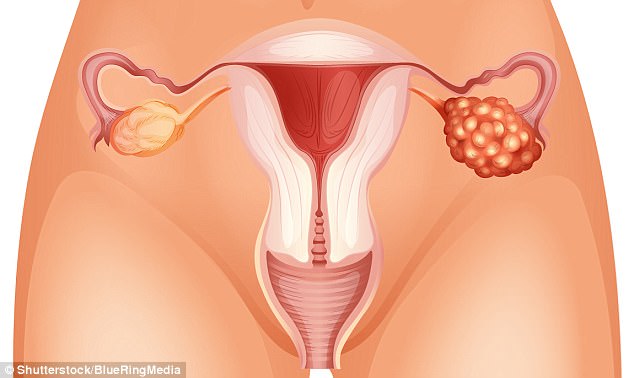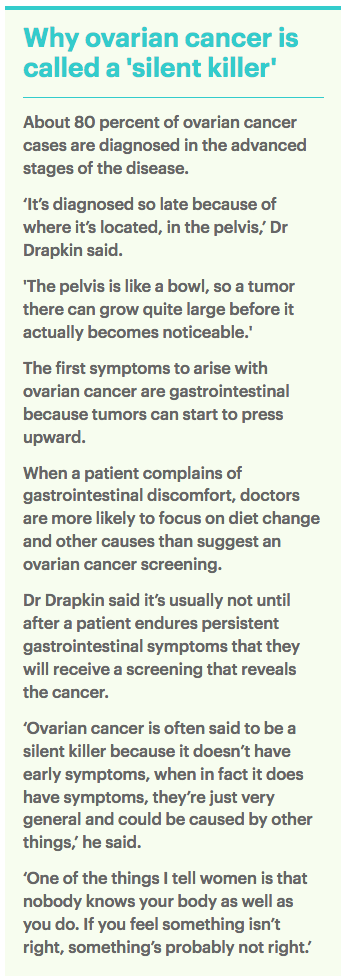‘Silent killer‘ begins in the fallopian tubes, study reveals – paving the way to better tests
 Two recent studies have confirmed previous claims that the deadly disease actually starts in the fallopian tubes.
Two recent studies have confirmed previous claims that the deadly disease actually starts in the fallopian tubes.
The discovery simultaneously gives researchers hope for developing better detection and prevention methods and highlights the alarming reality that very little is known about the disease.
Ovarian cancer has been called a ‘silent killer’ because there is no effective way to screen for it and it is generally diagnosed in the late stages.
Earlier this week a leading US task force declared that women should not be screened for the disease because it could lead to too many false positives.
Experts reacted to the panel’s announcement saying that something should be done to increase the validity of screenings.
Ovarian cancer is the fifth-leading cause of death among women with cancer, killing 14,000 women in the US each year.
Two studies identifying the fallopian tube as the source of the cancer were six days apart in October, shedding some light on the disease that doctors know very little about compared to other cancers.
Both studies looked at high-grade serous ovarian carcinoma (HGSOC) is the most frequent type of ovarian cancer with only 15 percent of those diagnosed surviving beyond five years.
They also both concluded that the majority of ovarian cancer cases start in the fallopian tubes.
Ron Drapkin, an associate professor of pathology in obstetrics and gynecology at the University of Pennsylvania, has been studying ovarian cancer for nearly two decades.
‘It’s been about 10 years since the first research came out about ovarian cancer starting in the fallopian tube,’ he told Daily Mail Online.
He said these two studies were ‘the last nails in the coffin.’
‘Before 2006 or 2007 no one had thoroughly looked in the fallopian tubes, so researchers kind of just stumbled upon all of the precursors to ovarian cancer,’ he said.
‘Since then we’ve been trying to understand what makes the fallopian tubes susceptible to the cancer.’
Dr Drapkin was one of the lead researchers of one of the studies published in the fall that looked at the fallopian tube from a genomic perspective.
 The study looked at the relationships between tumors in five patients, isolating early precursor lesions in 37 samples.
The study looked at the relationships between tumors in five patients, isolating early precursor lesions in 37 samples.
They used genetic profiling techniques to look for changes in the genetic material and patterns between the samples and patients.
‘We already basically knew that ovarian cancer began in the fallopian tube, but this study gave us the genomic evidence to support that idea,’ Dr Drapkin said.
There is a chance that a small number of cases start in somewhere other than the fallopian tube, but there has been no concrete evidence as to where that may be, according to Dr Drapkin.
The other study by researchers at the Perlmutter Cancer Center at NYU Langone Health in New York City looked at ovarian cancer tumor tissue samples from 96 women and compared them to samples from a group of healthy women.
The study concluded that the cancerous cells were most similar to fallopian tissue.
Ovarian cancer is often called a cousin to breast cancer because they are both linked to a BRCA gene mutation, but Dr Drapkin said that up until around 2010 very little was known about the former compared with the latter.
He remembers talking to a senior research about this early in his career and says the explanation was that ovarian cancer was a ‘black box’ with very few tools for detection and very little money in it.
One of the main reasons that ovarian cancer is difficult to study is that the tissue samples studied are thin and viewed two-dimensionally so it’s easy to miss potential signs.
‘Research has shown that the more cross-sections you can get, the more information you can find in the tissue,’ Dr Drapkin said.
Another key reason is that a vast majority of cases are diagnosed in the advanced stages when the tumor has already destroyed any precursors.
Going forward, Dr Drapkin says that the most valuable research will deal with prevention and early detection, both of which can benefit from the findings of the study.
‘There are two new early detection methods in the works right now that are heavily based on our findings,’ he said.
One is a scope that travels up into the fallopian tubes to collect cells for testing.
Another is a test similar to a pap smear that could take cells from the uterus and detect changes coming down from the fallopian tubes.
‘This method is based on the menstrual cycle and the idea that everything flows through the same path, so by testing downstream from the fallopian tubes we could detect potential signs.’
The findings are also being applied to prevention, specifically in women who have the BRCA1 or BRCA2 gene mutation associated with breast and ovarian cancer.
Women with BRCA mutations are given the option to remove their ovaries in order to prevent developing cancer. Knowing that the cancer begins in the fallopian tube means that the tubes could be removed as well.
Dr Drapkin said that 30 percent of women with BRCA mutations choose not to have their ovaries removed in part because it brings on menopause much earlier than normal.
There are studies in the works to see if removing the fallopian tubes at a younger age and saving the ovary removal until closer to the natural time of menopause would still be effective for prevention.
With regard to treatment, all cases of ovarian cancer are currently treated with the same chemotherapy. In most cases, there are good results early on, but the cancer usually recurs and becomes resistant to the chemo.
Applying the genomic research from the study could allow for more individualized and effective treatments.
Dr Drapkin said that it will be several years before significant changes are seen in the field of ovarian cancer, but that these recent studies are a big first step in a field that had very little research just a decade ago.
Written by Megan Sheets for The Daily Mail ~ February 14, 2018.
 FAIR USE NOTICE: This site contains copyrighted material the use of which has not always been specifically authorized by the copyright owner. We are making such material available in our efforts to advance understanding of environmental, political, human rights, economic, democracy, scientific, and social justice issues, etc. We believe this constitutes a ‘fair use’ of any such copyrighted material as provided for in section 107 of the US Copyright Law. In accordance with Title 17 U. S. C. Section 107, the material on this site is distributed without profit to those who have expressed a prior interest in receiving the included information for research and educational purposes. For more information go to: http://www.law.cornell.edu/uscode/17/107.shtml“
FAIR USE NOTICE: This site contains copyrighted material the use of which has not always been specifically authorized by the copyright owner. We are making such material available in our efforts to advance understanding of environmental, political, human rights, economic, democracy, scientific, and social justice issues, etc. We believe this constitutes a ‘fair use’ of any such copyrighted material as provided for in section 107 of the US Copyright Law. In accordance with Title 17 U. S. C. Section 107, the material on this site is distributed without profit to those who have expressed a prior interest in receiving the included information for research and educational purposes. For more information go to: http://www.law.cornell.edu/uscode/17/107.shtml“
